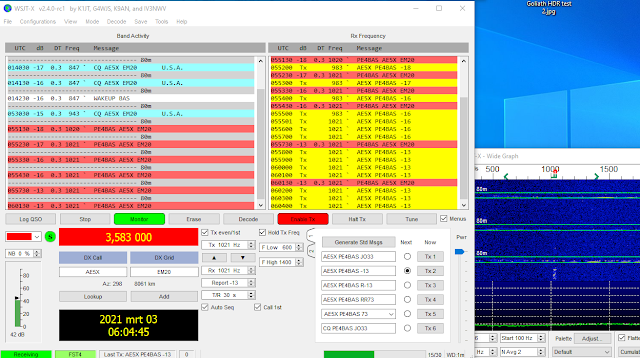Consulting VOACAP the best shortpath on 80m between Texas,USA and northern Netherlands is at 6 UTC. So, John AE5X and I made a sked on the new FST4/30s digital mode. I received John well, even saw strong traces in the waterfall and heard the audio. John didn't see my signal at all unfortunately. Actually if I look at the comparisation chart from DB6LL we should have tried Q65/30s which is at least 3 dB better.
Before setting up FST4 on 80m I decided to try on 160m FT8 again. And again I was spotted by DP0GVN with a excellent -8dB signal. You should almost think this is very common, but it isn't. The 160m band is only open for a few weeks on Antarctica. The horizontal loops are not hanging on poles by the way, they are just down on the ice. Information came from Felix DP1POL as given on his presentation in 2019. Besides that I worked a few new ones on 160m again.
I left the lonely AE5X FST4 spot from John on the map...



Thanks for trying, Bas. I made my first call on 60m FST4 about two hours before our sked with 140 watts. PSK Reporter shows that you received this at -11 dB. This told me that we could probably use 10 watts and be at -23 dB so I was quite surprised later when I couldn't copy your 100 watt signal at all.
ReplyDeleteAt times, before our sked, I transmitted at 90 watts and was never received by you - only when I was above 100 watts was I ever received, and then with strong dB values. I don't get it...
72 and thanks again,
John AE5X
It was certainly worth trying, at least half of the sked worked out :-)
DeletePropagation is not always reciproke. Besides that your dipole is at least at twice my inverted-V heigth. So you have a lower take off angle which is better for DX. If I change my 160m sloper to 80m I probabely had the chance to work you...if you like to try again some day with FST4 or Q65 let me know. 73, Bas
I spent some time this morning reading about Q65. At some point I saw mention that 6m QSO's out to 1600km are highly possible regardless of propagation conditions if 300 watts is used. That's pretty impressive.
DeleteSure, let's try an HF Q65 QSO. We will have to put in the frequency ourselves since WSJT-X only has freqs for 144 MHz and higher for this mode.
Maybe post a date, band (freq) and time for a "public sked" to your blog and see if others want to join for an HF test of this new mode.
73,
John AE5X
Here's the skinny on Q65:
Deletehttps://physics.princeton.edu/pulsar/k1jt/Q65_Quick_Start.pdf
Hi John, there already have been some Q65 experiments on HF. I know DB6LL has done some. It is not made for HF of course, but FST4 isn't made for HF either. Actually JT65/JT9 and FT8 also are not made for HF but very populair in the last years. But there is nothing against a experiment on 80m or any other HF band. I will think about this. Might be interesting to experiment 2 or 3 days in a row because propagation changes in time. What cannot happen at day one can happen in day 3 and the other way around. I'm very curious about the use of Q65 in the coming ES season on 6m. 73, Bas
ReplyDelete